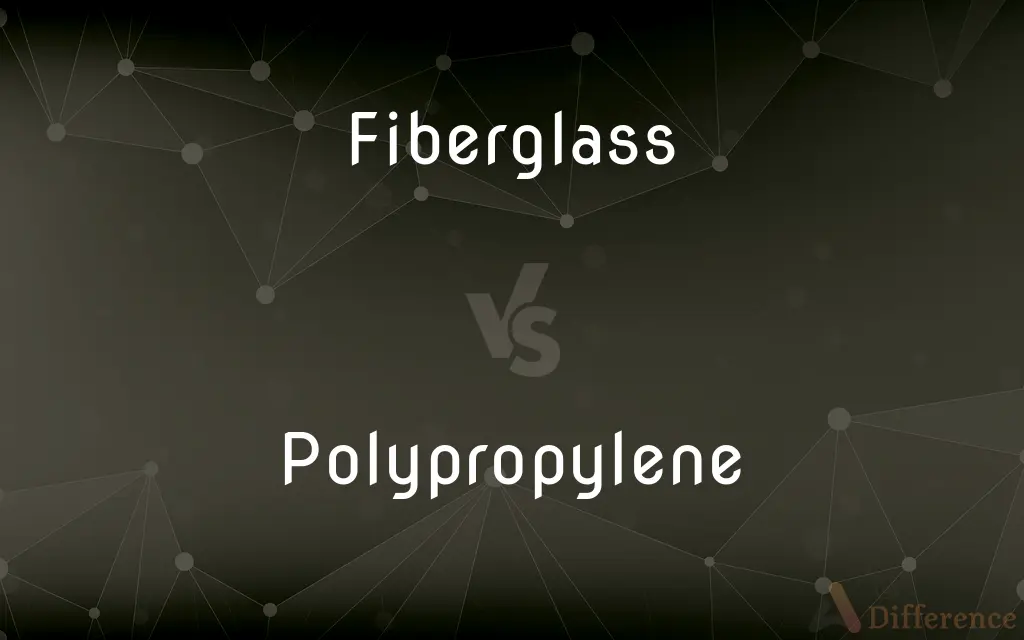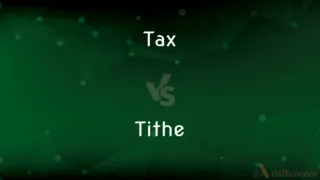Fiberglass vs. Polypropylene — What's the Difference?
By Tayyaba Rehman — Updated on November 4, 2023
Fiberglass is a composite material made of glass fibers, while polypropylene is a type of plastic polymer.

Difference Between Fiberglass and Polypropylene
Table of Contents
ADVERTISEMENT
Key Differences
Fiberglass is a material composed of glass fibers reinforced with resin, making it a composite. It is known for its high strength-to-weight ratio and is used in a multitude of applications from boats to insulation. Polypropylene, on the other hand, is a thermoplastic polymer used widely in packaging, textiles, and reusable containers. It is appreciated for its resistance to fatigue, chemical solvents, and bases.
Fiberglass, being a composite, can be shaped into complex forms and is often used where a lightweight and durable material is required. Its glass fibers provide reinforcement that gives it excellent tensile strength. Polypropylene does not have the reinforcement of fibers but is easier to mold and manufacture, which is why it is common in consumer goods and is often used in plastic parts and household objects.
In terms of thermal properties, fiberglass has superior thermal resistance and can tolerate higher temperatures without losing its structural integrity. This makes it a popular choice for high-temperature applications and insulating material. Polypropylene has a lower melting point and is not suitable for high-temperature environments, but it performs well for everyday products and can be a more cost-effective option.
Fiberglass is more brittle and can shatter upon high impact, whereas polypropylene is more resilient to bending and can withstand repeated flexing without deforming permanently. However, fiberglass’s brittleness is offset by its ability to be layered, which can absorb and disperse energy, making it valuable for protective equipment like helmets.
Regarding environmental concerns, both materials present challenges. Fiberglass requires careful handling due to its fine fibers which can irritate the skin and lungs. Polypropylene, while being recyclable, is a petroleum-based plastic that contributes to plastic pollution if not properly disposed of or recycled.
ADVERTISEMENT
Comparison Chart
Composition
Glass fibers reinforced with resin
Thermoplastic polymer
Strength
High tensile strength, brittle
Resilient to bending, less tensile strength
Thermal Resistance
Higher thermal resistance
Lower melting point
Environmental Impact
Irritant when handled, challenging disposal
Petroleum-based, recyclable, pollution concern
Common Uses
Boats, insulation, sports equipment
Packaging, textiles, automotive parts
Compare with Definitions
Fiberglass
Can be a health hazard due to its fine fibers if not handled properly.
Wear gloves and a mask when handling fiberglass insulation.
Polypropylene
Can be manufactured in a transparent form for consumer products.
The transparent polypropylene packaging allowed customers to see the product inside.
Fiberglass
Material composed of glass fibers embedded in resin.
The boat's hull was reinforced with layers of fiberglass.
Polypropylene
Often used in the automotive industry for making parts that don't carry heavy loads.
The car's interior features include polypropylene components.
Fiberglass
Has a high strength-to-weight ratio and is durable.
They chose fiberglass for the construction due to its durability.
Polypropylene
A type of thermoplastic polymer that is versatile and lightweight.
They stored the food in containers made from polypropylene.
Fiberglass
Poor conductor of electricity, often used for insulation.
Fiberglass insulation is standard in many homes.
Polypropylene
Resistant to chemical solvents and bases.
The laboratory bottles are made of polypropylene because it doesn't react with the chemicals.
Fiberglass
Resistant to corrosion, making it suitable for various climates.
Fiberglass is used in outdoor structures because it doesn't rust.
Polypropylene
Has a high fatigue resistance, suitable for reusable containers.
Polypropylene chairs are popular because they withstand frequent use.
Fiberglass
Fiberglass (American English), or fibreglass (Commonwealth English) is a common type of fiber-reinforced plastic using glass fiber. The fibers may be randomly arranged, flattened into a sheet (called a chopped strand mat), or woven into glass cloth.
Polypropylene
Polypropylene (PP), also known as polypropene, is a thermoplastic polymer used in a wide variety of applications. It is produced via chain-growth polymerization from the monomer propylene.
Fiberglass
A material consisting of extremely fine glass fibers, used in making various products, such as yarns, fabrics, insulators, and structural objects or parts. Also called spun glass.
Polypropylene
A synthetic resin which is a polymer of propylene, used chiefly for films, fibres, or moulding materials
High-impact polypropylene
Polypropylene underwear
Fiberglass
A lightweight, durable material consisting of synthetic resin reinforced with such fibers, used in applications such as roofing and boatbuilding.
Polypropylene
Any of various thermoplastic polymers of propylene. They are hard and tough, and are used to make molded articles and fibers.
Fiberglass
(American spelling) fibreglass
Polypropylene
A fabric of fibers made from any of these polymers.
Fiberglass
(American spelling) fibreglass
Polypropylene
A thermoplastic resin made by the polymerization of propylene, and used for films, fibres, or moulding materials. Also known as polypropene.
Fiberglass
A material made of fine glass fibers woven into a fabric-like form, and used in applications requiring heat resistance; it is also embedded in resins to make a pliable but strong composite material used as the main component of fishing rods and boat hulls, and replacing the sheet metal in some automobile bodies.
Polypropylene
A polymer of propylene used as a thermoplastic molding material
Fiberglass
A covering material made of glass fibers in resins
Common Curiosities
Can fiberglass be recycled?
Recycling fiberglass is challenging but possible, often through downcycling.
Is polypropylene considered environmentally friendly?
It is recyclable, but as a plastic, it can contribute to pollution if not managed correctly.
How are fiberglass and polypropylene different in strength?
Fiberglass has high tensile strength, while polypropylene is more flexible.
Why is fiberglass used for insulation?
Its poor thermal conductivity makes it an excellent insulator.
Is polypropylene safe for food storage?
Yes, food-grade polypropylene is safe for storing food.
Are there BPA concerns with polypropylene?
Polypropylene is generally BPA-free and considered safe for consumer products.
What is fiberglass?
Fiberglass is a reinforced plastic material made from glass fibers coated with resin.
What are common uses of fiberglass?
Common uses include boat hulls, automotive body parts, and insulation materials.
What is polypropylene commonly used for?
It's used for packaging, household goods, textiles, and automotive parts.
Can polypropylene handle high temperatures?
It has a lower melting point, making it unsuitable for high-temperature applications.
Are there health concerns with using fiberglass?
Yes, inhaling or contacting fiberglass fibers can cause irritation.
How do the costs of fiberglass and polypropylene compare?
Polypropylene is typically less expensive than fiberglass, which has a more complex manufacturing process.
Can fiberglass be molded into complex shapes?
Yes, fiberglass can be formed into complex shapes due to its composite nature.
What is the environmental impact of polypropylene?
It's petroleum-based and can contribute to pollution if not recycled.
How does the durability of fiberglass compare to polypropylene?
Fiberglass is more brittle but can be more durable due to its high strength.
Share Your Discovery

Previous Comparison
Pebble vs. Rock
Next Comparison
Tax vs. TitheAuthor Spotlight
Written by
Tayyaba RehmanTayyaba Rehman is a distinguished writer, currently serving as a primary contributor to askdifference.com. As a researcher in semantics and etymology, Tayyaba's passion for the complexity of languages and their distinctions has found a perfect home on the platform. Tayyaba delves into the intricacies of language, distinguishing between commonly confused words and phrases, thereby providing clarity for readers worldwide.















































